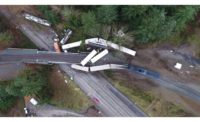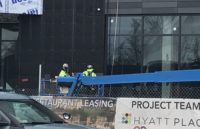By training a cross section of construction team members and testing their knowledge in a safety certification program, leaders of the American Road and Transportation Builders Association believe they can put a dent in the 48,600 injuries and deaths that take place in highway work zones each year. The group announced an ambitious goal of 1,000 completed transportation-related training certifications in 2017, the program’s first full year.
 Occupational Safety and Health Administration training courses issue course-completion cards for 10-hour and 30-hour courses. But OSHA’s cards “just show that you sat in a classroom,” said Ross Myers, chief executive of contractor Allan Myers and co-chair of new Safety Certification for Transportation Project Professionals Commission. ARTBA’s target audience of hundreds of thousands of potential workers would be certified to be able to “see a hazard, identify it and know that they should call it in,” he told ENR.
Occupational Safety and Health Administration training courses issue course-completion cards for 10-hour and 30-hour courses. But OSHA’s cards “just show that you sat in a classroom,” said Ross Myers, chief executive of contractor Allan Myers and co-chair of new Safety Certification for Transportation Project Professionals Commission. ARTBA’s target audience of hundreds of thousands of potential workers would be certified to be able to “see a hazard, identify it and know that they should call it in,” he told ENR.
The transportation safety-training program is timely as it relates to work-zone crashes. According to the U.S. Dept. of Transportation, those kinds of crash fatalities have been on the upswing since 2010, when there were 574. In 2015, the last year for which data is complete, fatalities climbed to 688. Drivers and passengers account for most of the deaths.
A concerted industry-government safety push, started about 16 years ago, has helped to limit the fatalities. But in a survey last year by the Associated General Contractors, almost half of highway contractors reported crashes in their work zones in the past year.
Trucks are involved in many accidents, and speeding, inattention and a false sense of security cause many. “The mind-set of people now is, ‘I’ve got a seat belt and airbags, and if I want to text someone, that’ll be OK,’ ” said Myers. “That is the mind-set of young people today.”
Proven safety measures, such as barriers to separate workers from vehicles and police cars stationed at jobsites, often are denied by cost-conscious transportation and police departments, he said. Radar-camera speed-detection systems, another tactic that is proven to cut down on the speed of motorists in work zones, have been scuttled in some states by laws promoted by motorist groups that believe such systems are error-prone and ineffective.
To advance the certification program, ARTBA’s Transportation Development Foundation populated the commission with leaders from government, contractors, unions, and insurance and engineering firms. Leaders of top design companies, such as WSP|Parsons Brinckerhoff and HNTB, are an important part of the mix.
To qualify for the certification, applicants must have experience in transportation construction or different types of academic training in engineering, construction management or safety. Successful completion requires passing a 2.5-hour, 120-question multiple-choice exam.
 David Walls, chief executive of Austin Industries and the other co-chair of the commission, explained why ARTBA leaders felt they had to start the certification program. “Our inaction can get people killed,” he said, referring to the obligation of those in authority positions not to commit “sins of omission.”
David Walls, chief executive of Austin Industries and the other co-chair of the commission, explained why ARTBA leaders felt they had to start the certification program. “Our inaction can get people killed,” he said, referring to the obligation of those in authority positions not to commit “sins of omission.”






Post a comment to this article
Report Abusive Comment